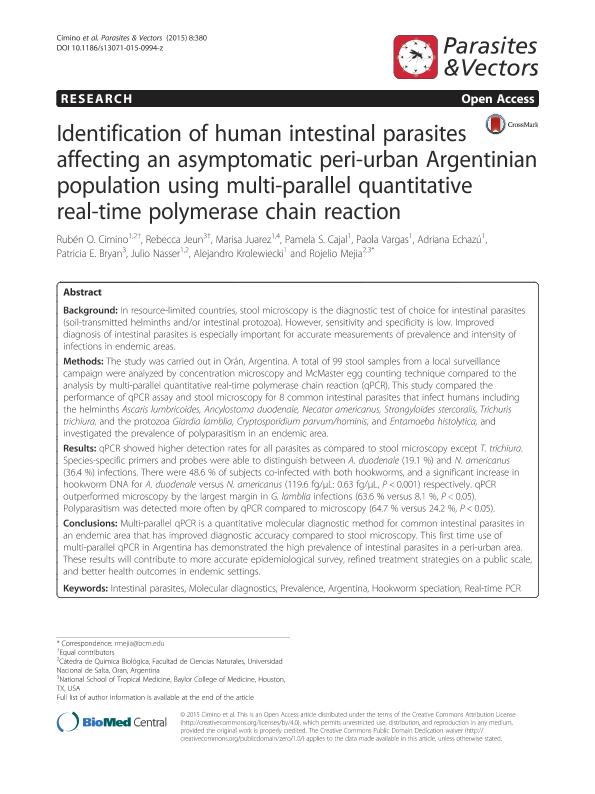Artículo
Identification of human intestinal parasites affecting an asymptomatic peri-urban Argentinian population using multi-parallel quantitative real-time polymerase chain reaction
Cimino, Rubén Oscar ; Jeun, Rebecca; Juarez, Marisa; Cajal, Pamela S.; Vargas Flores, Paola Andrea
; Jeun, Rebecca; Juarez, Marisa; Cajal, Pamela S.; Vargas Flores, Paola Andrea ; Echazú, Adriana
; Echazú, Adriana ; Bryan, Patricia E.; Nasser, Julio Rubén; Krolewiecki, Alejandro Javier
; Bryan, Patricia E.; Nasser, Julio Rubén; Krolewiecki, Alejandro Javier ; Mejia, Rojelio
; Mejia, Rojelio
 ; Jeun, Rebecca; Juarez, Marisa; Cajal, Pamela S.; Vargas Flores, Paola Andrea
; Jeun, Rebecca; Juarez, Marisa; Cajal, Pamela S.; Vargas Flores, Paola Andrea ; Echazú, Adriana
; Echazú, Adriana ; Bryan, Patricia E.; Nasser, Julio Rubén; Krolewiecki, Alejandro Javier
; Bryan, Patricia E.; Nasser, Julio Rubén; Krolewiecki, Alejandro Javier ; Mejia, Rojelio
; Mejia, Rojelio
Fecha de publicación:
07/2015
Editorial:
BioMed Central
Revista:
Parasites and Vectors
ISSN:
1756-3305
Idioma:
Inglés
Tipo de recurso:
Artículo publicado
Clasificación temática:
Resumen
Background: In resource-limited countries, stool microscopy is the diagnostic test of choice for intestinal parasites (soil-transmitted helminths and/or intestinal protozoa). However, sensitivity and specificity is low. Improved diagnosis of intestinal parasites is especially important for accurate measurements of prevalence and intensity of infections in endemic areas. Methods: The study was carried out in Orán, Argentina. A total of 99 stool samples from a local surveillance campaign were analyzed by concentration microscopy and McMaster egg counting technique compared to the analysis by multi-parallel quantitative real-time polymerase chain reaction (qPCR). This study compared the performance of qPCR assay and stool microscopy for 8 common intestinal parasites that infect humans including the helminths Ascaris lumbricoides, Ancylostoma duodenale, Necator americanus, Strongyloides stercoralis, Trichuris trichiura, and the protozoa Giardia lamblia, Cryptosporidium parvum/hominis, and Entamoeba histolytica, and investigated the prevalence of polyparasitism in an endemic area. Results: qPCR showed higher detection rates for all parasites as compared to stool microscopy except T. trichiura. Species-specific primers and probes were able to distinguish between A. duodenale (19.1 %) and N. americanus (36.4 %) infections. There were 48.6 % of subjects co-infected with both hookworms, and a significant increase in hookworm DNA for A. duodenale versus N. americanus (119.6 fg/μL: 0.63 fg/μL, P∈<∈0.001) respectively. qPCR outperformed microscopy by the largest margin in G. lamblia infections (63.6 % versus 8.1 %, P∈<∈0.05). Polyparasitism was detected more often by qPCR compared to microscopy (64.7 % versus 24.2 %, P∈<∈0.05). Conclusions: Multi-parallel qPCR is a quantitative molecular diagnostic method for common intestinal parasites in an endemic area that has improved diagnostic accuracy compared to stool microscopy. This first time use of multi-parallel qPCR in Argentina has demonstrated the high prevalence of intestinal parasites in a peri-urban area. These results will contribute to more accurate epidemiological survey, refined treatment strategies on a public scale, and better health outcomes in endemic settings.
Palabras clave:
Geohelmintos
,
Salta
,
Uncinarias
,
Rtpcr
Archivos asociados
Licencia
Identificadores
Colecciones
Articulos(CCT - SALTA-JUJUY)
Articulos de CTRO.CIENTIFICO TECNOL.CONICET - SALTA-JUJUY
Articulos de CTRO.CIENTIFICO TECNOL.CONICET - SALTA-JUJUY
Articulos(IPE)
Articulos de INST.DE PATOLOGIA EXPERIMENTAL
Articulos de INST.DE PATOLOGIA EXPERIMENTAL
Citación
Cimino, Rubén Oscar; Jeun, Rebecca; Juarez, Marisa; Cajal, Pamela S.; Vargas Flores, Paola Andrea; et al.; Identification of human intestinal parasites affecting an asymptomatic peri-urban Argentinian population using multi-parallel quantitative real-time polymerase chain reaction; BioMed Central; Parasites and Vectors; 8; 1; 7-2015
Compartir
Altmétricas



